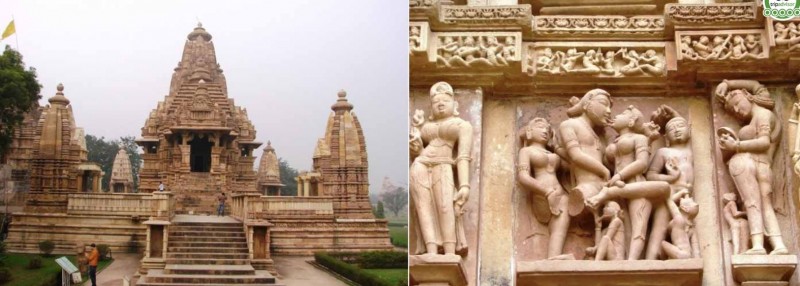
Lakshmana Temple is 10th century Hindu temple situated in Khajuraho, Madhya Pradesh. It was built by Yashovarman in Chandela Dynasty. It is dedicated to the lord Vaikuntha Vishnu and aspect of lord Vishnu. The Lakshmana Temple stands tall as a testament to the architectural marvels of the medieval era. Khajuraho, a UNESCO World Heritage Site, is renowned for its stunning collection of temples, and the Lakshmana Temple remains one of its most iconic and well-preserved structures.
The construction of the Lakshmana Temple is attributed to King Yasovarman, a notable ruler of the Chandela dynasty, who sought to create a grand temple dedicated to the Hindu god Vishnu. The temple was erected as a mark of devotion and also served as a place of worship for the king and his people. While the temple's original name remains shrouded in history, it eventually came to be known as the Lakshmana Temple, named after the king's son, Lakshmana.
Also Read: Kal Bhairav: Powerful Guardian and Protector
The Lakshmana Temple exemplifies the Nagara style of temple architecture, characterized by its curvilinear shikhara (tower) that tapers to a point. The temple rests on a raised platform, intricately adorned with various sculptures and friezes. The structure consists of a sanctum sanctorum, a vestibule, and a mandapa (hall) adorned with stunning carvings and sculptures. The main entrance, adorned with towering pillars, welcomes visitors into the exquisite world of Indian artistry.
The most remarkable aspect of the Lakshmana Temple lies in its intricate carvings and sculptures. Every inch of the temple's outer walls is covered in stunning depictions of gods, goddesses, celestial beings, mythical creatures, and various scenes from Hindu mythology. These intricate carvings showcase the artistic skills and devotion of the Chandela artisans, who brought to life the religious tales on the temple's stone canvas.
Also Read: Vamana Temple: Architectural Prowess of Ancient India
Prominent among these sculptures are the depictions of Vishnu in his various avatars, including the majestic Narasimha, the serene Rama, and the benevolent Krishna. Other sculptures portray scenes from the Mahabharata and Ramayana epics, showcasing the valor of heroes and the triumph of good over evil. The depiction of celestial nymphs, known as apsaras, adds a touch of ethereal beauty to the temple's grandeur.
The Khajuraho temples, including the Lakshmana Temple, are famous for their explicit erotic sculptures, which form a significant portion of the temple's artwork. These depictions have given rise to intriguing discussions about the temple's purpose, ranging from celebrating divine love to representing tantric practices. The erotic sculptures, however, should not overshadow the temple's overall religious context, which is dedicated to Vishnu and reflects the profound spirituality of the time.
Also Read: Duladeo Temple: Detailed Carving and Unique Architecture
The Lakshmana Temple conveys deep symbolic meaning. The intricate carvings and sculptures are not merely artistic embellishments but rather a manifestation of ancient spiritual beliefs and philosophies. The temple's design and layout are rooted in the principles of Vastu Shastra, an ancient Indian architectural system that seeks harmony with cosmic energies.
The sanctum sanctorum houses the main deity, a four-armed Vishnu standing in a majestic posture. This central figure is a representation of the divine and serves as a focal point for devotees' worship and meditation. The temple's spatial organization, aligned with cardinal directions, reflects the significance of cosmic order and the balance between human life and the universe.
Also Read: Telika Temple: Architectural Splendor
The Lakshmana Temple, like other Khajuraho temples, serves as a cultural time capsule, providing invaluable insights into the religious, social, and artistic aspects of medieval India. These temples were a center of religious and cultural activities, where people gathered for festivals, rituals, and other community events.
The Lakshmana Temple at Khajuraho stands as an exceptional testament to India's rich heritage, artistic finesse, and spiritual significance. Its intricate carvings, mesmerizing sculptures, and architectural brilliance continue to enthrall visitors, offering a glimpse into the cultural tapestry of ancient India. As a living testament to the brilliance of medieval artisans and the enduring power of spirituality, the Lakshmana Temple remains a source of wonder and inspiration for all who have the privilege of experiencing its magnificence.
Also Read: Matangeshwar Temple: Houses The Lingam
Rameshwaram Popular Travel Destination To Visit
Discover the Power of Beetroot: 5 Remarkable Health Benefits You Need to Know